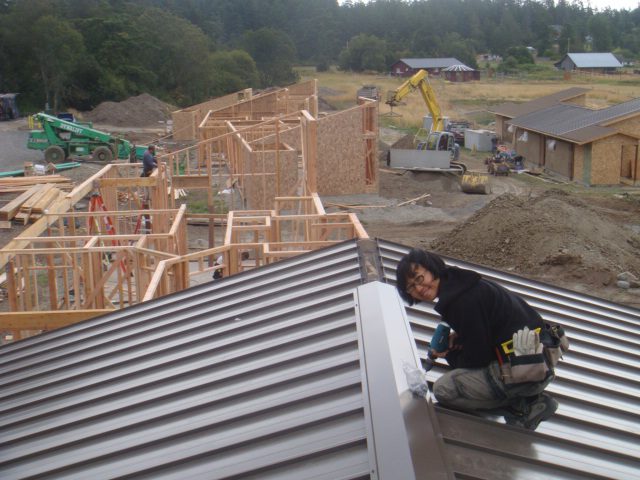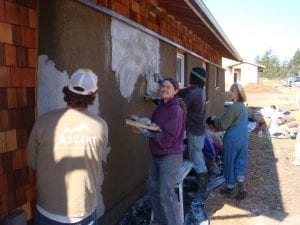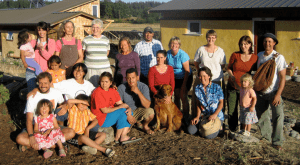
Chom Greacen puts metal roofs on one of the houses. Photo courtesy of the Lopez Community Land Trust

Contractors, residents, interns, and volunteers worked together to put on a lime coat on the straw-bale wall. Photo courtesy of the Lopez Community Land Trust
Over a decade ago, Lopez Community Land Trust (LCLT) combined community control of land, permanent affordability, permaculture principles, a net-zero energy goal, green designs, individual empowerment and fun, into one ambitious housing development project. It involved building 11 highly efficient and beautiful straw bale homes for low-income residents on Lopez Island.
The project, called Common Ground, was so compelling my husband and I decided to make significant shifts in our careers and move our family with two young kids across the Pacific to his hometown so we could be part of what we so hungered for: hope. We started off as volunteers and ended up staying as residents.
During the construction process, we and other prospective residents helped build each other’s houses as part of our sweat-equity contributions. The process transformed me from a soft-handed city dweller to an empowered woman who knew how to shingle a house and install metal roofing.
We residents worked alongside interns and contractors. A broad community of volunteers and professionals contributed talents, time, energy, and funds to make it possible for us to afford a home. I feel deep gratitude and humility to be on the receiving end of such generosity.
The construction process not only built homes but also community. Our kids can roam freely and safely and borrow ingredients from neighbors to make cookies. We share plants and harvests, look after each other’s garden and pets. Now our two kids and three other neighborhood kids have grown up and are in a school band together. Living here nurtures a sense of trust, of safety and of being part of something bigger than one self. It also gives us a sense of belonging that keeps us rooted in our soul.

The original residents of the Common Ground Co-op in 2008 soon after they moved into the community. Photo courtesy of the Common Ground Co-op
To become part of the Common Ground community, we all had to fall within a band of income high enough to pay our share of the collective mortgage but low enough to be considered low-income. The housing project is to serve the residents of Lopez Islands. So those who join the community must also live here currently, have grown up here, or have secured at least a two-year work contract. These two requirements (financial and geographic) are set and enforced by the land trust. The rest (choosing who to join the community) is up to the Common Ground coop. The initial set of residents was selected on a first come first serve basis. After that, the co-op (each household holds a share in the coop) decides together who will join when there is a vacancy. Because we are all financially tied together (the Coop holds a collective mortgage and each household pays a monthly assessment that goes toward paying down the mortgage as well as paying the land lease fee the land trust, insurance, etc.), we pay attention to financial risks of the candidates interested in joining our community. We then have an interview process and a community discussion to choose the candidate household that best fits our community. There is no hard and fast rule on how we decide what the “best fit” is.
I appreciate that we are quite diverse in terms of occupation (sheet rockers, artists, stone masons, paramedics, life coaches, energy consultants, business owners, landscapers, sheep farmer, retirees, etc.), race/nationality (Whites, Filipinos, Thais, Mexicans, British and Texans), ages, and world views. It feels like we are a microcosm of the bigger world.
The land on which our houses are built is owned by the land trust but the Common Ground coop stewards it in partnership with the land trust. We, residents, take turns serving on the board of the coop and all share inputs and decision making roles on issues pertaining the coop and use of land.
So many problems in the world can be traced to the fact that land and resource allocation is not based on needs but on a system driven by profits. That the LCLT forever removes the land on which our houses are built from the speculative market so that working families may afford a modest home is both a revolutionary act and a medicine for the soul. It shifted my way of being and seeing the world in a profound way. I have come to embrace real returns that come from investing in the slow buildup of soil and the thriving of community. I have also come to see that community matters. We, residents of low-income housing, matter. I, too, matter.


Love the article Chom, and your focus points. Great photo of you on the roof. Sandy
Love the article and how personal you make it. Bravo to all of you there.